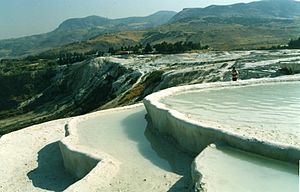Pamukkale
| UNESCO World Heritage Site | |
|---|---|
 | |
| Criteria | Mixed: iii, iv, vii |
| Reference | 485 |
| Inscription | 1988 (12th Session) |

Pamukkale, meaning "cotton castle" in Turkish, is a natural site and attraction in south-western Turkey in the Denizli Province. The ancient city of Hierapolis was built on top of the white "castle" which is in total about 2700 meters long and 160m high. It can be seen from a great distance, eg. when driving down the hills on the opposite side of the valley to the town of Denizli, which is 20 km away. Pamukkale is located in Turkey's Inner Aegean region, in the River Menderes valley, which enjoys a temperate climate over the greater part of the year.
The tectonic movements that took place in the fault depression of the Menderes river basin did not only cause frequent earthquakes, but also gave rise to the emergence of a number of very hot springs, and it is the water from one of these springs, with its large mineral content — chalk in particular — that created Pamukkale. Apart from some radioactive material, the water contains large amounts of hydrogen carbonate and calcium, which leads to the precipitation of calcium bi-carbonate. The effect of this natural phenomenon leaves thick white layers of limestone and travertine cascading down the mountain slope, making the area look like a fortress of cotton or a frozen waterfall.

Pamukkale is a very famous tourist attraction of Turkey, and tourists travel from the coast of Antalya and the Aegean Sea to this place as it is one of two World Heritage Sites in Turkey, together with Hierapolis. Only a few other places in the world are somewhat similar, such as the Mammoth Hot Springs in the USA, and HuangLong in SiChuan Province of China (another UNESCO World Heritage Site).
Unfortunately, Pamukkale was abused for decades in the late 20th century, as hotels were built on top of the site, destroying parts of the remains of Hierapolis. The hot water was taken to fill the hotel pools, and the waste water was even spilled over the monument itself turning it brownish. In addition, a tarmac road ramp was built right into the main part. People walked around with shoes, washed themselves with soap and shampoo in the pools, and even rode bikes and motorbikes up and down the slopes.
After UNESCO turned its attention to Pamukkale, and the site was dramatically losing its attraction, the officials finally acted. The hotels were demolished, and the road ramp was covered with artificial pools which nowadays are, unlike the most other parts, accessible to bare-footed tourists. Even tadpoles can be found in there. A small trench was carved along the outside of the ramp, to collect the water and prevent it from spilling in the "wrong" places. These brownish parts are left to be bleached by the sun first, without being covered by water, as this would worsen the problem. Many pools are thus empty. Others parts are covered with water for an hour or two according to a schedule which is on display on top of the hill.
The underground volcanic activity which causes the hot springs, also caused carbon dioxide to seep into a cave which as a result was called the Plutonium (= "place of the god of the dead").
Sister Cities
The village of Pamukkale has one sister city
Similar places
- Geothermal areas of Yellowstone in the USA
- Pink and White Terraces in New Zealand (destroyed in 1886 by volcano eruption)
